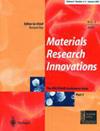钴掺杂氮化镓的相关电子和光磁性能
Q2 Engineering
引用次数: 1
摘要
在Perdew-Burke Ernzerhof提出的广义梯度近似和超软赝势框架下,利用密度泛函理论(DFT)第一性原理计算研究了钴掺杂对氮化镓电子、磁性和光学性质的影响。掺杂钴的氮化镓的电子能带结构由纯形式的半导体变为半金属,并显著降低。Co和N位的磁矩分别为0.8 μB和0.12 μB。Co浓度的增加导致自旋极化和Co磁矩本身的减小。根据现象学能带结构模型,随着Co浓度的增加,p-d斥力增加,Co浓度的增加导致自旋极化降低,从而由于Co t2d和ed态之间可能的电荷转移导致d-d耦合增加。不同掺杂浓度的Co - d-Dos图显示出更宽的t2d水平,从而预测了随着掺杂浓度的增加稳定性的增加。Co原子之间的耦合是铁磁性的,通过相邻的Ga和N原子介导。随着掺杂浓度的增加,共掺杂GaN的吸收边出现红移。这些结果与实验结果吻合较好。我们预测较低浓度的钴掺杂氮化镓适合自旋电子应用。本文章由计算机程序翻译,如有差异,请以英文原文为准。
Correlated Electronic and Opto-magnetic Properties of Cobalt Doped GaN
The effect of cobalt doping on the electronic, magnetic and optical properties of GaN has been investigated using density functional theory (DFT) first-principles calculations within the framework of generalized gradient approximation suggested by Perdew-Burke Ernzerhof and ultrasoft pseudopotential. The electronic band structure of cobalt (Co) doped GaN turns into half metallic rather than semiconducting in its pure form and reduces significantly too. The values of magnetic moment at Co and nitrogen (N) sites are 0.8 μB and 0.12 μB, respectively. The effect of the increase in Co concentration results in reduced spin-polarization and the Co magnetic moment itself. According to phenomenological band structure model, the p-d repulsion increases with increasing Co concentration, which subsequently lowers the spin-polarization and hence the d-d coupling increases due to possible charge transfer between Co t2d and ed states. The Co d-Dos diagram for various doping concentrations exhibits more broadened t2d levels, thus predicting the increase in stability with increase in dopant concentration. The coupling between Co atoms is ferromagnetic, mediated through neighboring Ga and N atoms. The absorption edge of Co-doped GaN manifests a red shift with the increase in doping concentration. These findings are in good agreement with the experimental results. We predict that a lower concentration of cobalt-doped GaN is appropriate for spintronic applications.
求助全文
通过发布文献求助,成功后即可免费获取论文全文。
去求助
来源期刊

Materials Research Innovations
工程技术-材料科学:综合
CiteScore
5.20
自引率
0.00%
发文量
38
审稿时长
2.8 months
期刊介绍:
Materials Research Innovations covers all areas of materials research with a particular interest in synthesis, processing, and properties from the nanoscale to the microscale to the bulk. Coverage includes all classes of material – ceramics, metals, and polymers; semiconductors and other functional materials; organic and inorganic materials – alone or in combination as composites. Innovation in composition and processing to impart special properties to bulk materials and coatings, and for innovative applications in technology, represents a strong focus. The journal attempts to balance enduring themes of science and engineering with the innovation provided by such areas of research activity.
 求助内容:
求助内容: 应助结果提醒方式:
应助结果提醒方式:


